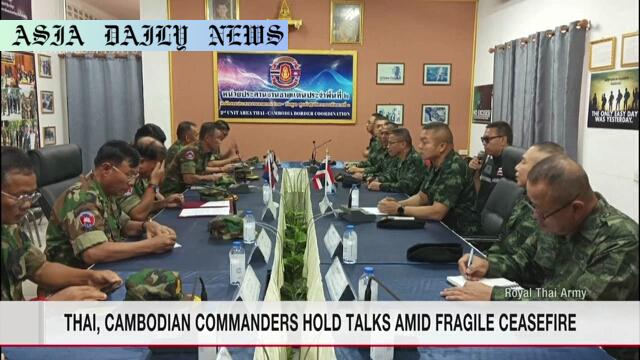Ceasefire: Thai and Cambodian commanders pledge to maintain peace and resolve disputes amid fragile border situation.

Ceasefire Amidst Tensions: A Fragile Pact
The border issue between Thailand and Cambodia has been a long-standing territorial dispute. Recently, the situation escalated into violent clashes that lasted five days, resulting in casualties that claimed both military and civilian lives. In response, military commanders from both sides convened for discussions aimed at de-escalating the conflict. On Tuesday, Thai and Cambodian commanders met at the border, agreeing to maintain the ceasefire and immediately address any disputes through newly formed coordination teams. The decision to mediate negotiations was spearheaded by Malaysia, this year’s ASEAN chair, resulting in an unconditional ceasefire agreement enacted at midnight on Monday.
While the ceasefire reflects a step towards peace, its implementation has been fraught with challenges. Thailand accused Cambodia of violating the agreement by launching attacks in several areas, which led to retaliatory action from Thai forces. Acting Prime Minister Phumtham Wechayachai criticized these actions as breaches of good faith. On the other hand, Cambodia’s Defense Minister Tea Seiha denied the accusations, affirming that Cambodian troops strictly followed the ceasefire terms.
The Role of ASEAN and Coordination Efforts
The involvement of ASEAN emphasizes the regional significance of the conflict and the broader implications it has for stability within Southeast Asia. The establishment of coordination teams seeks to prevent further escalations and enable immediate resolution of newly arising issues. Given the history of strained bilateral relations, the cooperation between these two nations is crucial but also complex.
Despite the fragility of the ceasefire, diplomatic efforts showcase a commitment to resolving disputes before they spiral into further violence. However, the commitment to these agreements depends on transparency, goodwill, and a genuine desire for lasting peace. As Thailand and Cambodia navigate this ceasefire, the significance of trust and accountability remains paramount.
The Human Cost of Conflict
The five days of border clashes brought about significant losses, with dozens of deaths reported, including civilians trapped in the violence. The human toll of such conflicts underlines the importance of diplomatic responses in resolving territorial disputes. Aside from the immediate casualties, prolonged clashes can displace communities, disrupt cross-border trade, and foster animosity that takes years to heal.
Both nations face the challenge of rebuilding trust—not just between their militaries but also among border communities that bear the brunt of such disputes. As military talks progress, the focus must also shift towards creating an environment conducive to economic and social cooperation. A resolution must go beyond the cessation of fire, working towards a sustainable framework for peaceful coexistence.
The resolution to this specific phase of the Thai-Cambodian conflict serves as a precedent for handling similar issues across the globe. Global observations and regional stakes make this ceasefire agreement more than just a bilateral matter; it is a testament to diplomacy’s role in modern geopolitics.
Commentary
Diplomacy: A Double-Edged Sword
The recent ceasefire agreement between Thailand and Cambodia exemplifies the tenuousness that often accompanies diplomatic efforts to resolve border disputes. While it is commendable that both nations have initiated talks and made a commitment to halt violence, the accusations of ceasefire violations reveal an underlying mistrust. This underscores the importance of follow-through mechanisms, like the coordination teams that have been established, ensuring accountability on both sides.
ASEAN’s Role: A Regional Mediator Takes Center Stage
ASEAN’s involvement in mediating this ceasefire adds an important layer of regional support and oversight. ASEAN has increasingly played a pivotal role in conflicts of this nature, reflecting its commitment to maintaining peace and stability within Southeast Asia. The regional bloc’s role in fostering dialogue between Thailand and Cambodia paves the way for future collaborative peacekeeping initiatives within the region.
However, ASEAN’s impact can only go as far as member nations allow, and continued efforts will be needed to ensure sustained diplomatic relations. Additionally, as global eyes focus on ASEAN’s handling of such bilateral issues, the bloc must maintain impartiality while actively providing solutions that address both immediate concerns and underlying grievances.
The Long Road Ahead: Building Trust and Peace
Trust remains the cornerstone of any lasting agreement. For Thailand and Cambodia to achieve a true resolution, there must be transparency and open communication. Beyond military agreements, both sides must engage in initiatives that promote cultural and economic cooperation, allowing for the gradual rebuilding of confidence between their governments and peoples.
Ultimately, this ceasefire is a step—not a solution. The path to peaceful coexistence requires consistent effort, mutual understanding, and a long-term vision of harmony that transcends national borders. The future of Southeast Asia’s stability hinges on such incremental progress.


